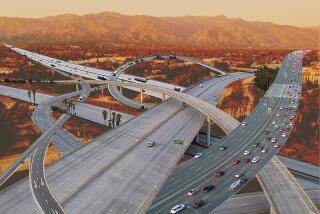On the Road Again: The Plight of the ‘90s Mother
- Share via
It starts first thing in the morning: Get up, drive the kids to school. Afternoons are worse: Pick them up, get one to Little League practice, take another to guitar lessons. Or shuttle them to the mall. Or drive them to Taco Bell. Or to basketball games. Or to the movies.
Sharon Muir lives that kind of life. She is the prototypical “soccer mom,” although in her case it isn’t soccer. It’s baseball, T-ball, softball, ice skating, choir rehearsals and hockey. She spends three or four hours every afternoon driving her three children to various points in South Pasadena.
“The kids need you,” said the former defense attorney, who gave up her career to play the role of chauffeur, but who never imagined just how much her free time would be squeezed.
Mothers today are under more pressure than ever to haul children around and run family errands, according to a report released Wednesday by the Surface Transportation Policy Project, a Washington-based consortium of environmental and community groups. The average American mother with school-age children spends more than an hour a day driving, chopped up into more than five trips. She turns the ignition far more often than her husband and spends more time behind the wheel than she does in conversation or in one-on-one child care, the report concluded.
In the Los Angeles area, a region that bred the soccer mom, the situation is even more acute. Towns are spread out, public transportation is inadequate and many parents are afraid to let their children go very far on foot or on their bikes, said Gloria Ohland, a spokeswoman for the organization’s Los Angeles office.
“I’m a mother . . . and I know this is true,” she said. “Everybody’s driving a lot more, but women are driving more than men, and women with children are driving more than anybody.”
Jacqueline Ontiveros is a case in point. The working mother, who lives in Rosemead and commutes to East Los Angeles, gets up at 4 a.m. to prepare her two children for school.
Her daughter, Samantha, goes to preschool at one location. Her son, Nicolas, attends second grade somewhere else. Their schedules are different, and Samantha has to be picked up during Mom’s lunch hour. On Tuesday nights, Nicolas has Boy Scout meetings. The freeway traffic is often so bad that Ontiveros ends up taking surface streets. It seems sometimes as if she spends her whole life in her 1986 Volkswagen.
“It’s a lot of running around,” she said. “I’ve been doing it for three years now, so there are days when I just can’t handle it. There are days when it’s impossible.”
Wendy Mathis, a divorced mother who lives in Burbank, has children ages 9, 11 and 13.
“Sometimes I think my kids just want me for money, clothes, food and rides,” she said with a tired laugh.
Mathis is the typical mother, according to the national study. She said she spends well over an hour in her car each day, driving the kids to and from two different schools and football and baseball practices.
“There are days when I make six trips,” she said. “One forgets her lunch. Another has practice.”
Even when she is not chauffeuring the kids around, she is running errands for them.
“I go to the grocery store almost every day,” Mathis said. “Teenagers eat all the time.”
And, like Ontiveros, she keeps the motor running on weekends. There are practices, games, trips to the mall and trips to see friends.
The study, based on national surveys and research literature, compared driving patterns in 1990 and 1995 to look for trends, said project spokeswoman Ohland. The number of trips that women made rose 13%, she said. Married women with children made about 20% more trips than men or childless women.
Fewer children are riding their bikes and fewer are walking to school, the report said.
Although some women enjoy whisking their children to activities and keeping in close touch with their lives, the demands of the road are sometimes so intense that families suffer, especially in households with two working parents.
“There’s no time left for dinner or homework or playtime or any meaningful communication before you have to get in bed and get ready to get up in the morning and start all over again,” said Ohland, a resident of Mt. Washington, near downtown, whose 9-year-old daughter takes skating lessons.
In Wisconsin, where Ohland grew up, children got around on their own. In Los Angeles, they bum rides because everything is too far or their parents are afraid they’ll be abducted.
“I feel like my daughter’s my hostage,” Ohland said. “She can’t do anything unless I have the time to enable her to do it. She has to sit at home.”
To accommodate their children without sacrificing unreasonable amounts of their own time, some mothers form carpools. China Iiams, a Carson mother of two, has an arrangement with a friend so that each mom drives the kids to school for a week.
On her weeks, Iiams faces a tough schedule. The drive to school takes 20 minutes, then she drives another 20 minutes to reach a Metrolink station, where she boards a train to downtown L.A. If not for the carpooling, “I would have gone mad,” she said. “It was so bad before. I was rushing, rushing all the time. I was a nervous wreck.”
Cathy Acosta of Temple City also shares the driving with other mothers, but she is in a tough spot. Her job ends before school gets out, and she is often the only parent who is home with a car. It can be especially annoying when teenagers take the ride for granted.
“They don’t even ask us sometimes,” said Acosta, who has a 14-year-old daughter. “[They say,] ‘Mom, you’re taking us to Shelly’s house after school.’ They assume that you’re available for them.
“You always want to be accommodating to your children,” she added, “but sometimes you just have to tell them no. . . . Every once in a great while, all the parents reach that level at the same time and everybody stays home.”
A number of mothers, like Taraneh Tamadon of Irvine, have scaled down their work schedules. With a 3-year-old daughter and a 7-year-old son, she commutes only three days a week to the auto glass company she owns in Marina del Ray. On Tuesdays and Thursdays, she works at home and drives her son to his ice skating and soccer classes. Their father helps when he can.
Acting as chauffeur can be “frustrating,” she said, “but when they look at you and smile at you, that’s when you really enjoy it.”
Deborah Curtis, a Hermosa Beach stay-at-home mother, would agree. She has four kids, ages 8, 11, 14 and 16, and they attend three schools. One son is an avid golfer who competes in tournaments two hours away.
It’s great that her children can be involved in things, she said. But there is a price to pay.
“I pretty much live in my van,” she said.
(BEGIN TEXT OF INFOBOX / INFOGRAPHIC)
On the Move
Women spend significantly more time than men driving their children places and running household errands. A new report says that women are spending more time than ever behind the wheel-more than an hour a day.
Women’s Trips 1995
Social and recreational: 24%
Work: 16%
Church and school: 9%
Other: 0.2%
Errands and chauffeuring: 50%
*
Men’s Trips 1995
Social and recreational: 26%
Work: 25%
Church and school: 9%
Other: 0.1%
Errands and chauffeuring: 41%
*
NOTE: Figures may not total 100 because of rounding
Source: Surface Transportation Project
More to Read
Sign up for Essential California
The most important California stories and recommendations in your inbox every morning.
You may occasionally receive promotional content from the Los Angeles Times.










